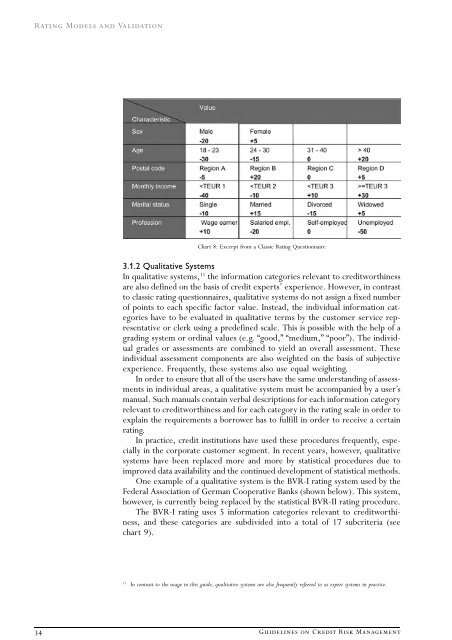Rating Models and Validation - Oesterreichische Nationalbank
Rating Models and Validation - Oesterreichische Nationalbank
Rating Models and Validation - Oesterreichische Nationalbank
Create successful ePaper yourself
Turn your PDF publications into a flip-book with our unique Google optimized e-Paper software.
<strong>Rating</strong> <strong>Models</strong> <strong>and</strong> <strong>Validation</strong><br />
Chart 8: Excerpt from a Classic <strong>Rating</strong> Questionnaire<br />
3.1.2 Qualitative Systems<br />
In qualitative systems, 11 the information categories relevant to creditworthiness<br />
are also defined on the basis of credit expertsÕ experience. However, in contrast<br />
to classic rating questionnaires, qualitative systems do not assign a fixed number<br />
of points to each specific factor value. Instead, the individual information categories<br />
have to be evaluated in qualitative terms by the customer service representative<br />
or clerk using a predefined scale. This is possible with the help of a<br />
grading system or ordinal values (e.g. Ògood,Ó Òmedium,Ó ÒpoorÓ). The individual<br />
grades or assessments are combined to yield an overall assessment. These<br />
individual assessment components are also weighted on the basis of subjective<br />
experience. Frequently, these systems also use equal weighting.<br />
In order to ensure that all of the users have the same underst<strong>and</strong>ing of assessments<br />
in individual areas, a qualitative system must be accompanied by a userÕs<br />
manual. Such manuals contain verbal descriptions for each information category<br />
relevant to creditworthiness <strong>and</strong> for each category in the rating scale in order to<br />
explain the requirements a borrower has to fulfill in order to receive a certain<br />
rating.<br />
In practice, credit institutions have used these procedures frequently, especially<br />
in the corporate customer segment. In recent years, however, qualitative<br />
systems have been replaced more <strong>and</strong> more by statistical procedures due to<br />
improved data availability <strong>and</strong> the continued development of statistical methods.<br />
One example of a qualitative system is the BVR-I rating system used by the<br />
Federal Association of German Cooperative Banks (shown below). This system,<br />
however, is currently being replaced by the statistical BVR-II rating procedure.<br />
The BVR-I rating uses 5 information categories relevant to creditworthiness,<br />
<strong>and</strong> these categories are subdivided into a total of 17 subcriteria (see<br />
chart 9).<br />
11 In contrast to the usage in this guide, qualitative systems are also frequently referred to as expert systems in practice.<br />
34 Guidelines on Credit Risk Management

















